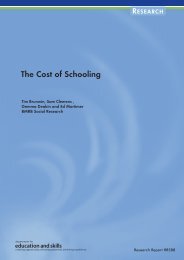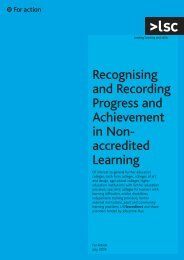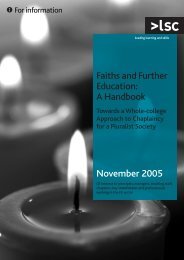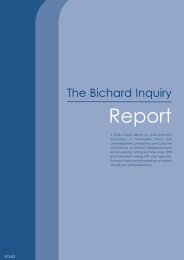The Learning and Skills Councils Annual Report and Accounts for ...
The Learning and Skills Councils Annual Report and Accounts for ...
The Learning and Skills Councils Annual Report and Accounts for ...
You also want an ePaper? Increase the reach of your titles
YUMPU automatically turns print PDFs into web optimized ePapers that Google loves.
Table 1: Summary of depreciation methods<br />
Property, Plant<br />
<strong>and</strong> Equipment<br />
Intangible<br />
Fixed Assets<br />
Category<br />
Component<br />
(if applicable)<br />
Method<br />
Useful life<br />
IT Desktop IT Straight line 3 years<br />
Other IT Straight line 5 years<br />
Plant <strong>and</strong> machinery Straight line 3 years<br />
Furniture <strong>and</strong><br />
fittings<br />
Furniture Straight line 5 years<br />
Fitting out Straight line Less than 10 years or the duration of the<br />
building lease<br />
Internally developed systems Straight line 5 years<br />
Software licences Straight line Life of the licence or 3 years where none given<br />
For Property, Plant <strong>and</strong> Equipment the<br />
residual values, depreciation methods<br />
<strong>and</strong> useful life assumptions described<br />
in Table 1 shall be reviewed at least<br />
annually by each financial year-end.<br />
For Intangible Assets, amortisation<br />
periods <strong>and</strong> methods described in<br />
Table 1 shall be reviewed at least<br />
annually by each financial year-end.<br />
Any changes arising from these reviews<br />
will be accounted <strong>for</strong> as changes to<br />
accounting estimates.<br />
1.6 Revaluation<br />
For all classes of assets, revaluation<br />
shall be undertaken with sufficient<br />
regularity to ensure that carrying<br />
values do not differ materially from<br />
fair values. <strong>The</strong>re was no revaluation in<br />
2009–10.<br />
1.7 Impairment<br />
Property, Plant <strong>and</strong> Equipment <strong>and</strong><br />
Intangible Assets are subject to<br />
impairment reviews to ensure that<br />
they are carried at no more than the<br />
recoverable amount: the higher of net<br />
selling price or value in use. For each<br />
financial reporting period, the LSC will<br />
assess whether there are any internal<br />
or external indications of impairment<br />
in its assets <strong>and</strong> will estimate the<br />
recoverable amounts of any such<br />
assets affected.<br />
1.8 Subsequent measurement<br />
Where material, any surplus arising<br />
from indexation is recognised directly<br />
in a revaluation reserve within equity,<br />
except to the extent that the surplus<br />
reverses a previous revaluation<br />
deficit on the same asset recognised<br />
in the Net Expenditure Account, in<br />
which case the credit is to the Net<br />
Expenditure Account.<br />
1.9 Subsequent measurement –<br />
IT systems<br />
<strong>The</strong> LSC’s software systems have been<br />
designed <strong>and</strong> built specifically <strong>for</strong> LSC<br />
use. <strong>The</strong>y are not income generating<br />
<strong>and</strong> there was no active market <strong>for</strong><br />
them. As there are no appropriate<br />
indices to apply to these assets, the<br />
LSC there<strong>for</strong>e considers depreciated<br />
historical cost to be the most suitable<br />
model of depreciated replacement cost<br />
(as a proxy <strong>for</strong> fair value).<br />
1.10 Leases<br />
Operating leases <strong>and</strong> the rentals<br />
are charged to the Net Expenditure<br />
Account on a straight-line basis over<br />
the lease term.<br />
1.11 Receivables: programme<br />
expenditure<br />
Programme receivables derive from<br />
various programmes. <strong>The</strong>y mostly<br />
reflect part of the normal operation<br />
of the reconciliation process of the<br />
respective programme to ensure that<br />
only amounts earned on the basis of<br />
actual delivery are paid to providers<br />
<strong>and</strong> recorded in the LSC’s accounts.<br />
In the vast majority of cases, these<br />
amounts are offset against future<br />
payments to providers <strong>and</strong> recovered<br />
(usually in following month).<br />
<strong>The</strong> LSC also has receivables that are<br />
the result of assurance work. This work<br />
may determine either:<br />
• an actual amount that needs to be<br />
recovered from a provider, or<br />
• a data error that is extrapolated<br />
across the data population to<br />
determine an amount to be<br />
recovered from a provider.<br />
<strong>The</strong>se amounts are only included in<br />
the LSC’s accounts when a reliable<br />
value <strong>for</strong> the recovery has been<br />
established. In most cases, the<br />
amounts are recovered through<br />
in-year data adjustments that result in<br />
reduced future payments to providers.<br />
50 LSC <strong>Annual</strong> <strong>Report</strong> <strong>and</strong> <strong>Accounts</strong> 2009–10
















